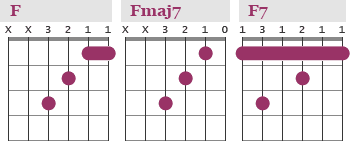

Likewise, if the lead in was a barred G, it is easier to keep the position and slide it to F. If the previous chord is a C, it is much easier just to play a Fmaj7 than to switch to a regular barred F, or a Hendrix thumb bar, or a power chord F. The thing is your fingerings will depend on context. If you want, try 1st fret low E string with thumb, otherwise, just mute it.Įdit: Also, the other person is right, Fmaj7 works as a substitute almost all the time. Other than that, you can store this information away for when it’s needed, or you can create a plan to practice slash chords more intentionally.First finger barred first fret B and high E strings

Look for slash chords in guitar music you already play (if you don’t find any, or are just starting, that’s fine).
#F BAR CHORD ALTERNATIVE DOWNLOAD#

This will aid memory and speed up learning. When we come to it, we can think of those notes as the original chord shape, altered. We can either figure out why the composer chose that version of the guitar chord, or simply notice how it’s used. Then, when we encounter them, we can identify them. If our main focus is on playing composed classical guitar pieces or arrangements, we can just keep an eye out for slash chords. However, it may be helpful to memorize the most common slash chords so it’s easier to recognize them in music. We can get along with no formal practice of slash chords.
#F BAR CHORD ALTERNATIVE HOW TO#
Many of the most common slash chords How to Practice Slash Chords So the most common slash chords will be “cowboy chords” (open-position chords) with a different bass note, though we do Most slash chords are “cowboy chords” with a different bass note. A slash chord (or chord inversion) would put either the E or G as the bass note. The difference is that a non-root note is in the lowest-sounding position.įor example, a C major chord contains the notes C, E, and G. This means that the other notes of the chord are the same. Most slash chords are “chord inversions”. However, by far the most common are simple chords with a different chord tone as the bass. In theory, we can put any bass note under any chord. Slash chords allow the composer or accompanist to keep the music interesting and novel. Many pieces move between just two or three chords for the entire piece. (A chord progression is a string of many chords or sequence of chords). Slash chords can also spice up simple or repetitive chord progressions. The F# remains the bass note below both the Bm and the F#7 chords. Sor’s Bm Etude Op35 no.22 uses a “pedal tone”.


 0 kommentar(er)
0 kommentar(er)
